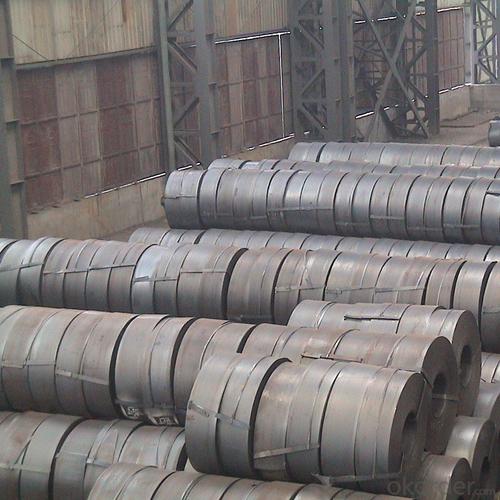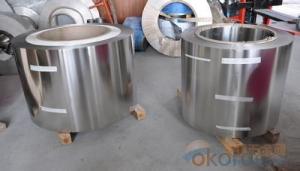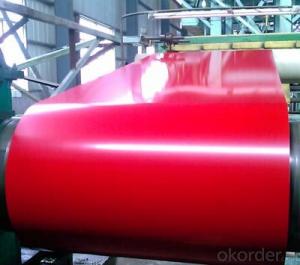Hot Rolled Steel Strip Coil Q195 Q235 in China
- Loading Port:
- Shanghai
- Payment Terms:
- TT or LC
- Min Order Qty:
- 25 m.t.
- Supply Capability:
- 1000000 m.t./month
OKorder Service Pledge
OKorder Financial Service
You Might Also Like
Specification
Applications of Steel Strip Coils:
1:Chemical industry equipment, Industrial tanks
2:Medical Instruments,Tableware, Kitchen utensil,kitchen ware
3:Architectural purpose, Milk & Food processing facilities
4:Hospital Equipment, interior Exterior decoration for building
5:Architectural purposes, escalators, kitchen ware,vehicles
Festures of Steel Strip Coils:
1. Each coil is closely covered by oil paper or plastic film.
2. Outside it is firmly packed with sack cloth or compound paper.
3. Steel strap or PP strap to pack the outside to ensure safety.
4. On/about 1000kgs to be packed with one wooden pallet.
5. Strips can be loaded to 20'FCL without pallet if required by customer.
6. LCL shipment can also be arranged once required by the customer.
Specifications of Steel Strip Coils:
| Description | Hot Rolled Steel Strip |
| Specification | 1.2-6.0mm*70mm |
| Standard | AISI, ASTM, BS, DIN, GB, JIS |
| Material | Q195,Q215,Q215B,Q235,Q235B |
| Application | Widly used in welding steel pipes, and bicycle making etc. |
| MOQ | 20 tons or according to customers’ requirement. |
| Port of Delivery | Tianjin Port of China |
| Remarks | We can provide qualify goods,competitive price and speedy delivery |
Images of Steel Strip Coils:


FAQ
1.What's your MOQ?
25MT, it is for one container.
2.Do you have QC teams?
Yeah, sure, our QC team is very important, they will keep the quality control for our products.
3. What's your normal delivery time?
Our delivery time about 10-20days for standard sizes, if you have other requirements like hardness and width ,it is about 20-40days.
- Q: What is the role of steel strips in the oil and gas industry?
- Steel strips play a crucial role in the oil and gas industry, primarily in the construction and maintenance of pipelines. These strips, typically made of high-quality steel, are used to form the core structure of pipelines, ensuring their strength, durability, and ability to withstand harsh operating conditions. One significant function of steel strips in the industry is to provide structural integrity to the pipelines. The strips are rolled into cylindrical shapes and welded together to create the pipeline's main body. This helps in transporting oil and gas over long distances, both onshore and offshore. The robust nature of steel makes it ideal for withstanding the high pressure and extreme temperature variations that pipelines are exposed to. Another vital role of steel strips is to protect the pipelines from corrosion. The oil and gas industry operates in diverse environments, which often include corrosive elements such as saltwater, chemicals, and gases. Steel strips are coated with anti-corrosion materials, such as epoxy or polyethylene, to create a protective layer that prevents rust and degradation. This coating also helps in reducing friction and improving the flow of oil and gas through the pipelines. Steel strips are also used in the fabrication of various equipment and components used in the oil and gas industry, such as storage tanks, drilling rigs, and offshore platforms. These equipment require high-strength steel strips to ensure stability, safety, and longevity, as they are subjected to heavy loads, extreme weather conditions, and harsh operational environments. In summary, steel strips are indispensable in the oil and gas industry due to their ability to provide structural integrity, corrosion resistance, and durability. By fulfilling these roles, steel strips contribute significantly to the safe and efficient transportation of oil and gas, as well as the construction of essential industry infrastructure.
- Q: How do steel strips perform in terms of magnetic properties?
- Steel strips generally have low magnetic properties, meaning they are not strongly attracted to magnets. However, the exact magnetic properties of steel strips can vary depending on the type and composition of the steel.
- Q: Can steel strips be used in the production of sporting equipment?
- Yes, steel strips can be used in the production of sporting equipment. They are versatile and strong, making them suitable for various applications such as the construction of tennis rackets, hockey sticks, and golf club shafts. Steel strips can provide the necessary durability and stability required for sporting equipment, enhancing performance and ensuring longevity.
- Q: How are steel strips used in the production of razor blades?
- Steel strips are an essential component in the production of razor blades. These strips are typically made from high-quality stainless steel, which offers excellent strength, durability, and resistance to corrosion. The use of steel strips ensures that razor blades are sharp, long-lasting, and capable of providing a smooth and precise shave. During the manufacturing process, steel strips are carefully cut into the desired dimensions and shape to form the blade. The strips are then heat-treated to enhance their hardness and toughness. This heat treatment process involves heating the steel to a specific temperature and then rapidly cooling it to create a hardened surface. This makes the blades more resistant to wear and tear, extending their lifespan. After the heat treatment, the steel strips are often coated with a thin layer of materials like chromium or platinum to further enhance their corrosion resistance and improve the overall shaving experience. These coatings also reduce friction, allowing the blades to glide smoothly across the skin without causing irritation or discomfort. Steel strips are then carefully shaped and honed to create the sharp cutting edge of the razor blade. This process involves grinding and polishing the steel to achieve a precise bevel and edge geometry, ensuring a clean and close shave. Overall, steel strips play a critical role in the production of razor blades by providing the necessary strength, durability, and sharpness required for an effective shaving tool. The use of high-quality steel strips guarantees that razor blades can deliver a smooth and comfortable shave while maintaining their performance over time.
- Q: How do steel strips respond to different surface coating processes?
- Steel strips respond differently to different surface coating processes based on the type of coating applied. For instance, galvanization, which involves coating steel with a layer of zinc, provides excellent corrosion resistance. On the other hand, electroplating with chrome enhances the steel's aesthetic appeal while providing moderate protection against corrosion. Additionally, powder coating offers a durable and decorative finish, while painting enables customization and can provide varying degrees of protection depending on the type of paint used. Ultimately, the response of steel strips to surface coating processes is influenced by the specific coating method and its intended purpose.
- Q: Are steel strips resistant to corrosion?
- Yes, steel strips are resistant to corrosion due to their protective layer of zinc coating or other surface treatments that prevent the metal from being exposed to moisture and oxygen, thus minimizing the risk of rust formation.
- Q: How are steel strips used in the production of pressure vessels?
- Steel strips are commonly used in the production of pressure vessels due to their durability, strength, and flexibility. These strips are typically made from high-quality steel alloys that can withstand high pressure and temperature conditions. In the manufacturing process, steel strips are often cut and shaped to form the desired dimensions and shape of the pressure vessel. This can be done through various methods such as shearing, laser cutting, or waterjet cutting. The strips are then formed into cylindrical or spherical shapes using techniques like rolling, bending, or welding. Once the desired shape is achieved, the steel strips are welded or joined together to create a seamless and leak-proof vessel. Welding is a critical step in pressure vessel fabrication as it ensures the structural integrity and prevents any potential leaks or failures under pressure. Additionally, steel strips can be used to reinforce the pressure vessel by adding extra layers or reinforcing rings. This helps to enhance the overall strength of the vessel and ensures its ability to withstand high internal pressures. Furthermore, steel strips are often coated or treated to protect against corrosion and enhance the longevity of the pressure vessel. Coatings such as epoxy, paint, or galvanization can be applied to prevent rusting and improve resistance to chemical reactions. Overall, steel strips play a crucial role in the production of pressure vessels by providing the necessary strength, flexibility, and durability required to withstand the demanding conditions and ensure the safety and reliability of these vessels.
- Q: How are steel strips tested for fatigue strength?
- Steel strips are tested for fatigue strength using a variety of methods. One common method is the rotating bending fatigue test, where a test specimen is subjected to cyclic loading under bending conditions. This test simulates the real-life conditions that the steel strip may encounter during its intended use. The specimen is mounted on a rotating shaft and subjected to a specified number of cycles until failure occurs. The number of cycles endured before failure is recorded, and this data is used to determine the fatigue strength of the steel strip. Another method used for testing fatigue strength is the axial fatigue test. In this test, the steel strip is subjected to cyclic loading in tension or compression. The specimen is loaded with a specified stress amplitude and subjected to a predetermined number of cycles until failure occurs. Similar to the rotating bending fatigue test, the number of cycles endured before failure is recorded and used to assess the fatigue strength of the steel strip. In addition to these mechanical tests, non-destructive testing techniques are also employed to evaluate the fatigue strength of steel strips. These techniques include ultrasonic testing, magnetic particle inspection, and dye penetrant inspection. Ultrasonic testing uses high-frequency sound waves to detect defects or cracks in the steel strip that may affect its fatigue strength. Magnetic particle inspection involves magnetizing the steel strip and applying iron particles to its surface to identify any surface cracks or defects. Dye penetrant inspection involves applying a dye to the steel strip's surface, which seeps into any cracks or defects, making them visible under certain lighting conditions. Overall, the testing of steel strips for fatigue strength involves subjecting the material to cyclic loading under controlled conditions, either through mechanical tests or non-destructive testing techniques. These tests provide valuable information about the steel strip's ability to withstand repeated loading and help ensure its suitability for various applications.
- Q: How are steel strips used in the manufacturing of escalators?
- Steel strips are used in the manufacturing of escalators to provide essential structural support, as they are strong and durable. These strips are typically used to construct the framework of the escalator, including the steps, handrails, and balustrades, ensuring the overall stability and safety of the escalator system.
- Q: What are the important considerations for storing steel strips?
- The important considerations for storing steel strips include proper environmental conditions, such as a dry and well-ventilated area to prevent rust or corrosion. It is also crucial to store them in a horizontal position to avoid warping or bending. Additionally, they should be stored away from any chemicals or substances that could damage the steel. Regular inspections and maintenance should be conducted to ensure their integrity and quality.
Send your message to us
Hot Rolled Steel Strip Coil Q195 Q235 in China
- Loading Port:
- Shanghai
- Payment Terms:
- TT or LC
- Min Order Qty:
- 25 m.t.
- Supply Capability:
- 1000000 m.t./month
OKorder Service Pledge
OKorder Financial Service
Similar products
Hot products
Hot Searches
Related keywords


























